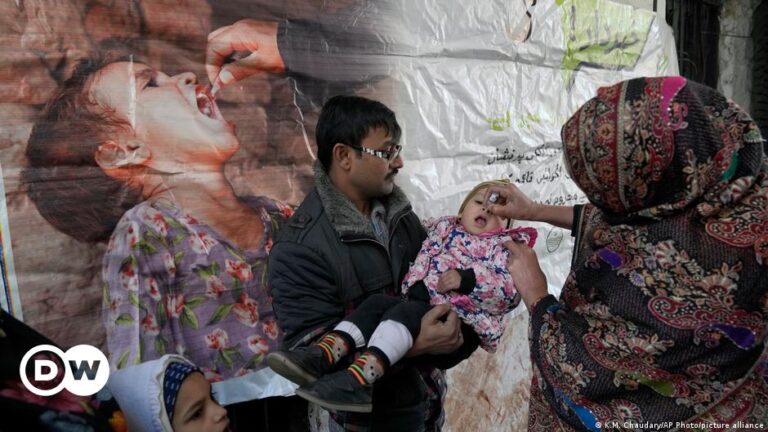Pakistan’s polio eradication campaign has been thrown into disarray after the South Asian nation of 240 million people reported its fifth case of the highly contagious poliovirus this year, dealing a new blow to the country’s efforts to eliminate the debilitating disease.
Four new cases of polio have been reported in the southwestern province of Balochistan, which borders Afghanistan, while a fifth has been reported in the southern province of Sindh, raising concerns about whether polio can be eradicated in the near future.
“This year’s cases are a harsh reminder that until Pakistan is completely polio-free, no child will be completely safe from this crippling disease,” said Malik Mukhtar Barras, Prime Minister Sharif’s national health services coordinator.
Polio, which most commonly affects children under the age of five and can be paralyzing and deadly, remains endemic in two countries – Afghanistan and Pakistan – according to the World Health Organization.
Six cases of polio were detected in Pakistan last year, and according to the Global Polio Eradication Initiative (GPEI), the country was very close to eradicating the disease with just one case reported in 2021.
Conspiracy theories impede progress
Experts believe that the cases emerging in Pakistan are due to a variety of factors.
“Pakistan and Afghanistan continue to operate in very complex and challenging environments,” Dr. Hamid Jafari, polio eradication director for the WHO’s Eastern Mediterranean region, told DW.
“Major risk factors include large population movements, insecurity compromising access and quality of vaccination in key transmission areas, significant community vaccine hesitancy, and persistently low routine immunization coverage in polio-endemic areas.”
“All five cases reported in Pakistan this year are linked to two YB3A-related genetic clusters following widespread cross-border transmission from Afghanistan. The cases have been reported from Chaman, Dera Bugti, Qila Abdullah, Shikarpur and Quetta,” Jafari added.
Polio vaccinators are frequent targets in Pakistan, where Islamic militants and hardline clerics accuse the government of running a vaccination campaign of being a foreign plot to sterilize Muslim children and a front for Western spies.
“Wide range detection is of particular concern as we are now entering a period of rapid transmission. The virus has re-established itself in our historical epicenters and is spreading from there. During this period of rapid transmission, we can expect further spread of infections,” Natalia Molodecky, who worked with GPEI at Pakistan’s Polio Emergency Operations Center in Islamabad, told DW.
“The main factor is the detection of the virus in areas that have been polio-free for many years due to a large and unexpected population movement, which is partly linked to the return of Afghan migrants,” Jafari stressed.
However, the five reported cases are not concentrated and have been reported from five different districts in the two states.
“Natural disasters like heavy rains, heat waves and floods can snowball, internal displacement can lead to lower vaccination coverage, and poor sewage treatment can lead to the polio virus entering water reservoirs. Lack of clean drinking water forces people to drink unsanitary water, increasing the risks,” Dr. Fareeha Irfan, a public health physician and expert who works in policy at the Punjab Health Board, told DW.
Sporadic infections are likely to continue “for the foreseeable future”
Experts warned that there could be a surge in polio cases in the coming days and that there is a real risk of the virus resurfacing in high-risk areas.
“Continued detection of poliovirus in environmental samples and sporadic cases will delay interruption of transmission beyond the planned end of 2024, possibly until the next low season in early 2025,” Jafari argued.
Molodecky agreed: “If polio continues to migrate from its core reservoir during epidemics, it could lead to increased numbers of cases outside historical reservoir areas,” the health expert said.
Despite significant progress in global efforts to eradicate the deadly virus, both Pakistan and Afghanistan continue to battle sporadic outbreaks, especially in remote areas where access to health services is hindered.
“Pakistan’s programme has reached a sophisticated level and has the resilience, capabilities, resources and support required to complete the mission,” Jafari asserted.
In the past, the diversion of human and infrastructure resources to issues considered more important has contributed to the increase in polio cases.
“Vaccine hesitancy has always highlighted the poor vaccination coverage in Pakistan. This trend was limited to the less educated sections of society but now even well-educated families are reluctant to get their children vaccinated, especially when it comes to oral vaccines,” Dr Irfan said.
How can we deal with this?
Experts suggest that urgent and intense efforts towards polio eradication must continue throughout this year to carefully identify and remap migrants and all unvaccinated children.
“To stop the epidemic, we must ensure that these overlooked children are vaccinated and interrupt the virus as quickly as possible in the historical epicenters – major population centres that have been polio-free for more than two years,” Jafari suggested.
The pattern of virus detection strongly suggests that people living in adjacent districts are contributing to the persistence and spread of the virus.
“When we talk about the source and origin of the virus, the source of the virus is usually our historical reservoir. So tackling the problem at the source is critical for sustained success. We know how to wipe out polio from these areas and we’ve done it before,” Molodecky stressed.
“In the coming months, it is essential to strengthen coordination and cooperation in efforts along the Afghanistan-Pakistan border, known as the ‘virus corridor,'” Jafari stressed.
Editor: John Silk
Before you go: Every Friday, the DW Asia newsletter brings you fascinating articles and videos from across the continent straight to your inbox. Sign up below.

